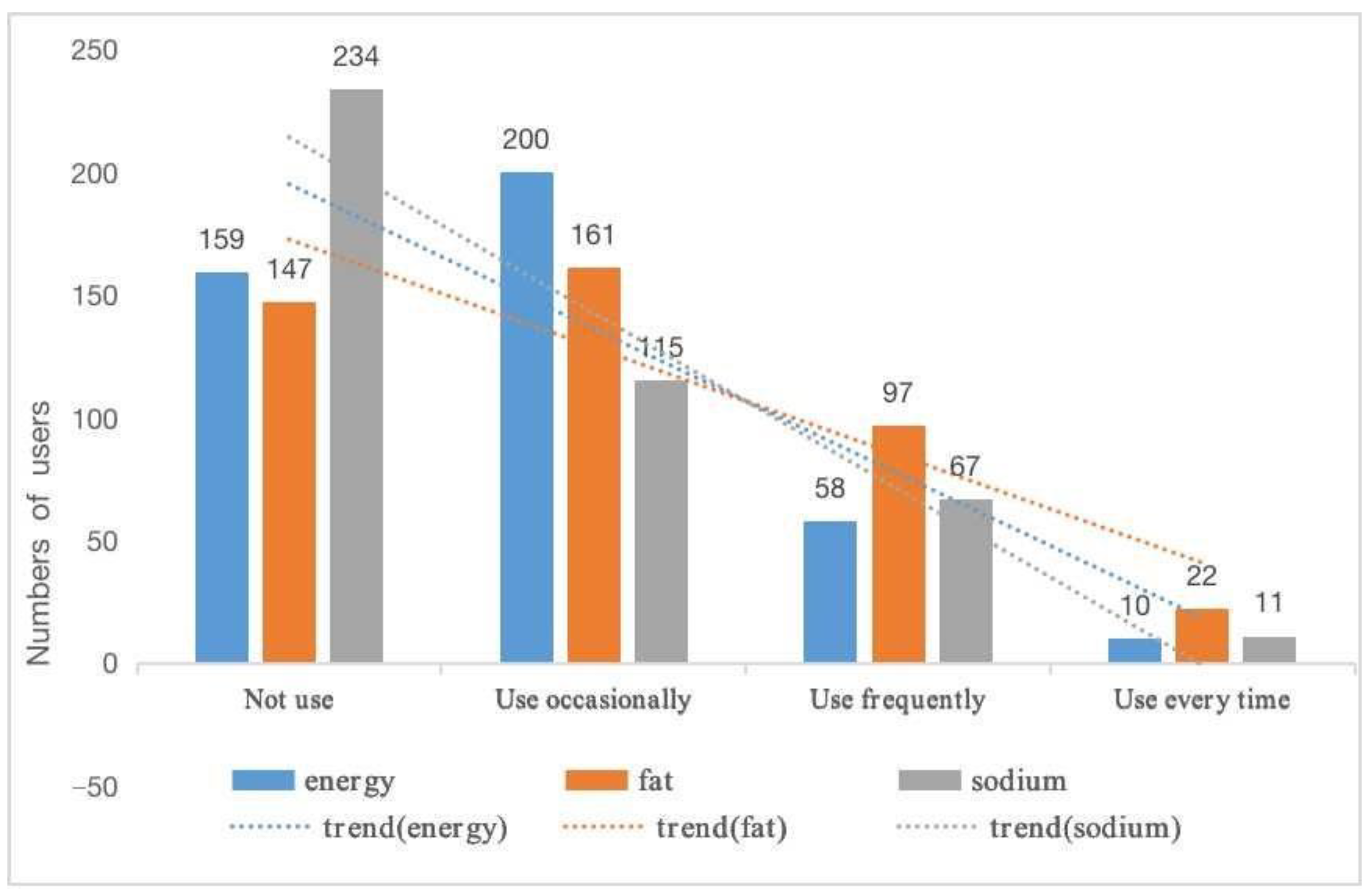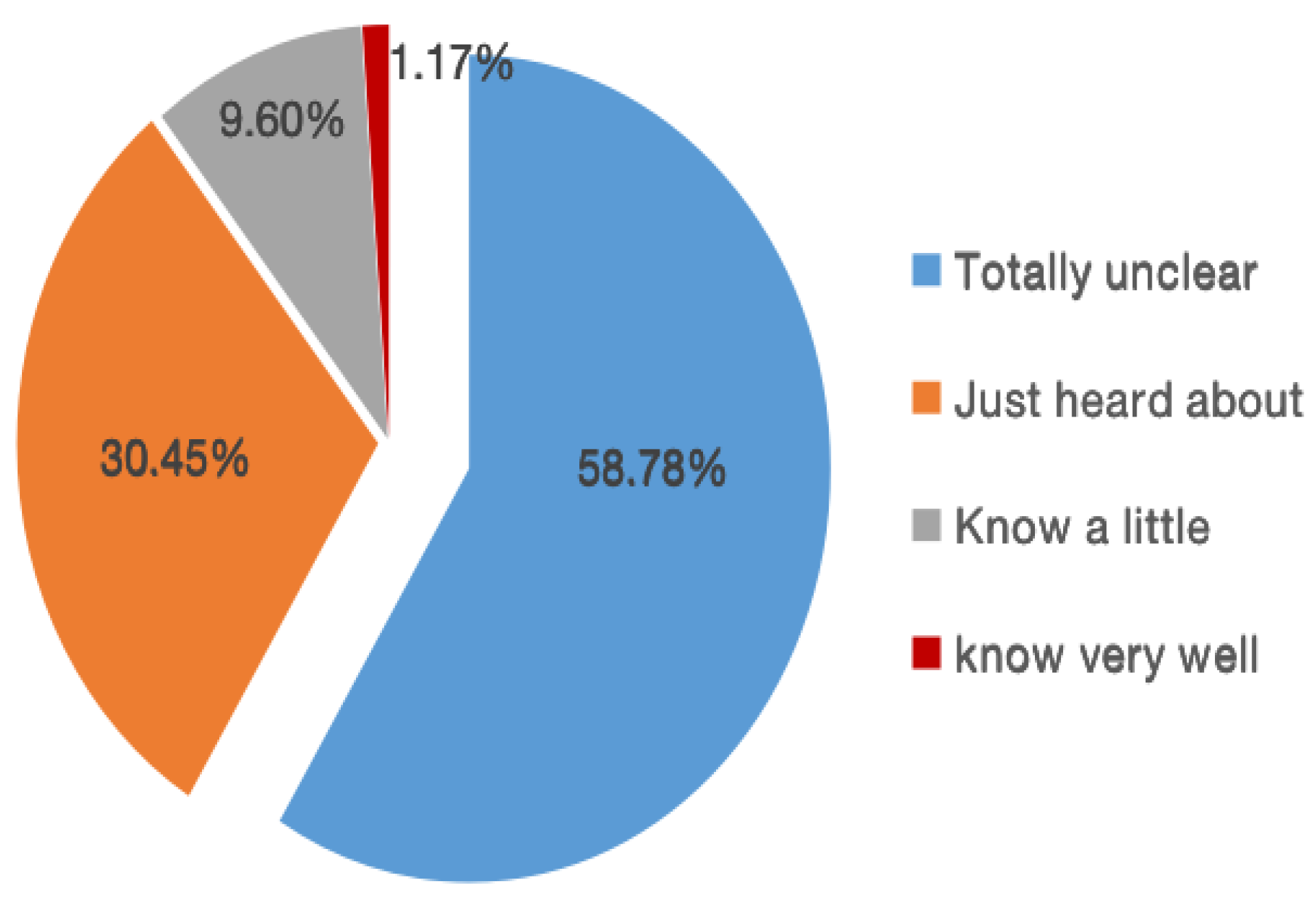Analysis of Factors Influencing Food Nutritional Labels Use in Nanjing, China
Abstract
1. Introduction
2. Methods and Materials
2.1. Data Collection
2.2. Questionnaire
2.3. Empirical Analysis
2.4. Household Characteristics
3. Results and Discussion
3.1. Usage of Food Nutrition Labels
3.2. Regression Results
3.3. Discussion
4. Conclusions
Author Contributions
Funding
Conflicts of Interest
References
- Liu, R.; Hoefkens, C.; Verbeke, W. Chinese consumers’ understanding and use of a food nutrition label and their determinants. Food Qual. Prefer. 2015, 41, 103–111. [Google Scholar] [CrossRef]
- Variyam, J.N. Do nutrition labels improve dietary outcomes? Health Econ. 2008, 17, 695–708. [Google Scholar] [CrossRef] [PubMed]
- Campos, S.; Doxey, J.; Hammond, D. Nutrition labels on pre-packaged foods: A systematic review. Public Health Nutr. 2011, 14, 1496–1506. [Google Scholar] [CrossRef] [PubMed]
- Christoph, M.J.; Ellison, B. A cross-sectional study of the relationship between nutrition label use and food selection, servings, and consumption in a university dining setting. J. Acad. Nutr. Diet. 2017, 117, 1528–1537. [Google Scholar] [CrossRef] [PubMed]
- Fisher, G. Nutrition labeling reduces valuations of food through multiple health and taste channels. Appetite 2018, 120, 500–504. [Google Scholar] [CrossRef]
- Smed, S.; Edenbrandt, A.K.; Jansen, L. The effects of voluntary front-of-pack nutrition labels on volume shares of products: The case of the Dutch Choices. Public Health Nutr. 2019, 22, 2879–2890. [Google Scholar] [CrossRef]
- Lundeberg, P.J.; Graham, D.J.; Mohr, G.S. Comparison of two front-of-package nutrition labeling schemes, and their explanation, on consumers’ perception of product healthfulness and food choice. Appetite 2018, 125, 548–556. [Google Scholar] [CrossRef]
- Graham, D.J.; Jeffery, R.W. Predictors of nutrition label viewing during food purchase decision making: An eye tracking investigation. Public Health Nutr. 2012, 15, 189–197. [Google Scholar] [CrossRef]
- Gębski, J.; Jezewska-Zychowicz, M.; Szlachciuk, J.; Kosicka-Gębska, M. Impact of nutritional claims on consumer preferences for bread with varied fiber and salt content. Food Qual. Prefer. 2019, 76, 91–99. [Google Scholar] [CrossRef]
- Ministry of Health of the People’s Republic of China (MOH). The Regulation of Food Nutrition Labeling. 2008. Available online: http://www.gov.cn/gzdt/2008-01/11/content_856260.htm (accessed on 22 December 2019).
- Hu, F.B.; Liu, Y.; Willett, W.C. Preventing chronic diseases by promoting healthy diet and lifestyle: Public policy implication for China. Obes. Rev. 2011, 12, 552–559. [Google Scholar] [CrossRef]
- Rimpeekool, W.; Seubsman, S.A.; Banwell, C.; Kirk, M.; Yiengprugsawan, V.; Sleigh, A. Food and nutrition labeling in Thailand: A long march from subsistence producers to international traders. Food Policy 2015, 56, 59–66. [Google Scholar] [CrossRef] [PubMed]
- Mulders, M.D.; Corneille, O.; Klein, O. Label reading, numeracy, and food & nutrition involvement. Appetite 2018, 128, 214–222. [Google Scholar] [PubMed]
- Cowburn, G.; Stockley, L. Consumer understanding and use of nutrition labeling: A systematic review. Public Health Nutr. 2005, 8, 21–28. [Google Scholar] [CrossRef] [PubMed]
- Bialkova, S.; van Trijp, H. What determines consumer attention to nutrition labels? Food Qual. Prefer. 2010, 21, 1042–1051. [Google Scholar] [CrossRef]
- Hieke, S.; Pieniak, Z.; Verbeke, W. European consumers’ interest in nutrition information on (sugar-free) chewing gum. Food Qual. Prefer. 2018, 64, 172–180. [Google Scholar] [CrossRef]
- Sharf, M.; Sela, R.; Zentner, G.; Shoob, H.; Shai, I.; Stein-Zamir, C. Figuring out food labels. Young adults’ understanding of nutritional information presented on food labels is inadequate. Appetite 2012, 58, 531–534. [Google Scholar] [CrossRef]
- Carrillo, E.; Varela, P.; Fiszman, S. Influence of nutritional knowledge on the use and interpretation of Spanish nutritional food labels. J. Food Sci. 2012, 77, H1–H8. [Google Scholar] [CrossRef]
- Nørgaard, M.K.; Brunsø, K. Families’ use of nutritional information on food labels. Food Qual. Prefer. 2009, 20, 597–606. [Google Scholar] [CrossRef]
- Nayga, R.M., Jr.; Lipinski, D.; Savur, N. Consumers’ use of nutritional labels while food shopping and at home. J. Consum. Aff. 1998, 32, 106–120. [Google Scholar] [CrossRef]
- Drichoutis, A.C.; Lazaridis, P.; Nayga, R.M. Consumers’ use of nutritional labels: A review of research studies and issues. Acad. Mark. Sci. Rev. 2006, 9, 1–22. [Google Scholar]
- Kim, S.Y.; Nayga, R.M., Jr.; Capps, O., Jr. Food label use, self-selectivity, and diet quality. J. Consum. Aff. 2001, 35, 346–363. [Google Scholar] [CrossRef]
- Govindasamy, R.; Italia, J. The influence of consumer demographic characteristics on nutritional label usage. J. Food Prod. Mark. 2000, 5, 55–68. [Google Scholar] [CrossRef]
- Mhurchu, C.N.; Eyles, H.; Jiang, Y.; Blakely, T. Do nutrition labels influence healthier food choices? Analysis of label viewing behavior and subsequent food purchases in a labeling intervention trial. Appetite 2018, 121, 360–365. [Google Scholar] [CrossRef] [PubMed]
- Jacobs, S.A.; de Beer, H.; Larney, M. Adult consumers’ understanding and use of information on food labels: A study among consumers living in the Potchefstroom and Klerksdorp regions, South Africa. Public Health Nutr. 2011, 14, 510–522. [Google Scholar] [CrossRef]
- Ollberding, N.J.; Wolf, R.L.; Contento, I. Food label use and its relation to dietary intake among US adults. J. Am. Diet. Assoc. 2011, 111, S47–S51. [Google Scholar] [CrossRef]
- Talati, Z.; Egnell, M.; Hercberg, S.; Julia, C.; Pettigrew, S. Food choice under five front-of-package nutrition label conditions: An experimental study across 12 countries. Am. J. Public Health 2019, 109, 1770–1775. [Google Scholar] [CrossRef]
- Arrúa, A.; Curutchet, M.R.; Rey, N.; Barreto, P.; Golovchenko, N.; Sellanes, A.; Ares, G. Impact of front-of-pack nutrition information and label design on children’s choice of two snack foods: Comparison of warnings and the traffic-light system. Appetite 2017, 116, 139–146. [Google Scholar] [CrossRef]
- Besler, H.T.; Buyuktuncer, Z.; Uyar, M.F. Consumer understanding and use of food and nutrition labeling in Turkey. J. Nutr. Educ. Behav. 2012, 44, 584–591. [Google Scholar] [CrossRef]
- Grunert, K.G.; Wills, J.M.; Fernández-Celemín, L. Nutrition knowledge and use and understanding of nutrition information on food labels among consumers in the UK. Appetite 2010, 55, 177–189. [Google Scholar] [CrossRef]


| District | Supermarket Surveyed | Number of Samples | Percentage (%) |
|---|---|---|---|
| Xuanwu | Jinrunfa (Ruijin Road) | 39 | 19.44 |
| Carrefour (Daxinggong) | 44 | ||
| Qinhuai | Huarun Suguo (Yinlong Garden) | 35 | 17.10 |
| Wal-Mart (Changle Road) | 38 | ||
| Jianye | Carrefour (Jiqingmen Street) | 46 | 18.03 |
| Auchan (Hanzhongmen Street) | 31 | ||
| Gulou | Lotte Mart (Central Road) | 32 | 17.56 |
| Jinrunfa (Caochangmen Street) | 43 | ||
| Xixia | Huarun Suguo (Xianlin Store) | 58 | 13.58 |
| Jiangning | Huarun Suguo (Gold Coast Plaza) | 61 | 14.29 |
| Statistical Indicators | Classification Index | Number of Samples | Proportion (%) |
|---|---|---|---|
| Gender | Male | 208 | 48.71 |
| Female | 219 | 51.29 | |
| Age | 18–30 | 113 | 26.46 |
| 31–40 | 121 | 28.34 | |
| 41–50 | 100 | 23.42 | |
| 51–60 | 66 | 15.46 | |
| >61 | 27 | 6.32 | |
| Education level | Junior high school and below | 72 | 16.86 |
| high school or technical secondary school | 107 | 25.06 | |
| Undergraduate or college | 200 | 46.84 | |
| Master degree and above | 48 | 11.24 | |
| Marital status | Unmarried | 99 | 23.19 |
| Married | 328 | 76.81 | |
| Income(Yuan) | (≤2000) | 7 | 1.64 |
| (2000, 4000) | 17 | 3.98 | |
| (4000, 6000) | 52 | 12.18 | |
| (6000, 8000) | 51 | 11.94 | |
| (8000, 10,000) | 152 | 35.60 | |
| (≥10,001) | 148 | 34.66 |
| Variables | B | Wald | Sig. | Exp (B) |
|---|---|---|---|---|
| Comprehension | 1.464 *** | 23.281 | 0.000 | 4.324 |
| Purchasing experience | 1.710 *** | 19.742 | 0.000 | 5.529 |
| Taste | −0.819 *** | 6.905 | 0.009 | 0.441 |
| Nutritional value | 0.994 *** | 4.399 | 0.036 | 2.703 |
| Major shopper | −0.545 * | 3.346 | 0.067 | 0.580 |
| Chronic disease | 0.807 *** | 8.259 | 0.004 | 2.242 |
| Diet awareness | 0.470 ** | 5.784 | 0.016 | 1.601 |
| Nutritional knowledge | 0.372 * | 2.932 | 0.087 | 1.451 |
| Age | 0.225 * | 3.705 | 0.054 | 1.253 |
| Work sector | 0.968 ** | 5.040 | 0.025 | 2.634 |
| Constant | −7.555 | 36.790 | 0.000 | 0.001 |
| Log-likelihood | 116.314 | |||
| Cox & Snell R Square | 0.485 | |||
| Nagel kerke R Square | 0.679 | |||
Publisher’s Note: MDPI stays neutral with regard to jurisdictional claims in published maps and institutional affiliations. |
© 2020 by the authors. Licensee MDPI, Basel, Switzerland. This article is an open access article distributed under the terms and conditions of the Creative Commons Attribution (CC BY) license (http://creativecommons.org/licenses/by/4.0/).
Share and Cite
Zhang, J.; Zhai, L.; Osewe, M.; Liu, A. Analysis of Factors Influencing Food Nutritional Labels Use in Nanjing, China. Foods 2020, 9, 1796. https://doi.org/10.3390/foods9121796
Zhang J, Zhai L, Osewe M, Liu A. Analysis of Factors Influencing Food Nutritional Labels Use in Nanjing, China. Foods. 2020; 9(12):1796. https://doi.org/10.3390/foods9121796
Chicago/Turabian StyleZhang, Jing, Liangliang Zhai, Maurice Osewe, and Aijun Liu. 2020. "Analysis of Factors Influencing Food Nutritional Labels Use in Nanjing, China" Foods 9, no. 12: 1796. https://doi.org/10.3390/foods9121796
APA StyleZhang, J., Zhai, L., Osewe, M., & Liu, A. (2020). Analysis of Factors Influencing Food Nutritional Labels Use in Nanjing, China. Foods, 9(12), 1796. https://doi.org/10.3390/foods9121796






